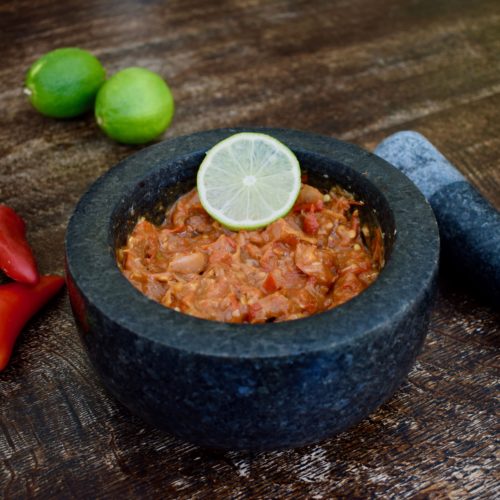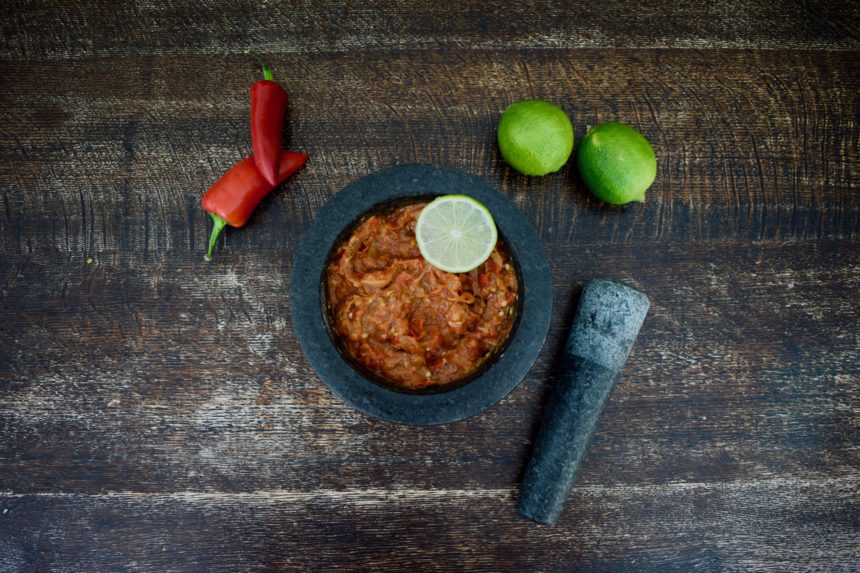
Sambals, or Indonesian chilli sauces, are central to Indonesian cuisine. There are literally hundreds of types, and I would say sambal terasi (or Indonesian shrimp paste sambal) is the most ubiquitous of all.
Shallots, garlic, tomatoes, salt, sugar and plenty of chillies are fried and ground together with terasi (Indonesian shrimp paste) to make a rustic, deep red paste that is as addictive as it is hot.
The terasi really is the key ingredient – it gives the hot sauce a rich umami undertone that separates it from other chilli sauces you may have tried.
This sambal terasi recipe requires only 10 minutes’ cooking and can be ground in a food processor to save time. Best of all, it can be frozen in portions so that you have an incredible supply of authentic Indonesian sambal at your fingertips.
This supply of sambal terasi is traditionally served with vegetables or fried/barbecued meat and fish. However, I like to defrost a bit with any meal that can benefit from a bit of heat and richness (tacos, curries – you name it).
This article will guide you through:
- What is sambal terasi?
- How sambal terasi recipes vary across Indonesia (no two are ever the same!)
- A detailed step-by-step sambal terasi recipe (I combined my favourite parts from all the variants of sambal terasi I ate across Indonesia)
- Why I make my sambal terasi like I do and how you can experiment to find your own favourite sambal terasi recipe
Or, if you want to jump straight to the recipe and only browse the notes when needed, then just click the button below:

What is sambal terasi?
In a nutshell, sambal terasi is an Indoensian shrimp paste sambal made from chillies, tomatoes, garlic, shallots, lime juice, palm sugar and shrimp paste.
It is served with anything from fried chicken and fish (ayam/ikan goreng) to raw vegetables.
Although there are literally hundreds of sambals across Indonesia, I would say that sambal terasi is your ‘bread and butter’ sambal. Ask for a sambal in a warung and maybe 7 times out of 10 you will get something that lies at the terasi end of the sambal spectrum.
It’s not that sambal terasi is the simplest sambal available (that award probably goes to sambal bawang – simply raw garlic and chilli), it’s more that this classic combination of flavours and is well-loved throughout Indonesia.
The key ingredient that sets it apart from other sambals is of course the terasi. Terasi is an Indonesian shrimp paste made from small sun-dried shrimp (similar to Malaysian belacan or Thai kapi).
Like the shrimp pastes in Thai and Malaysian cuisines, terasi is added to Indonesian dishes to give a strong hit of umami. In some dishes, including some versions of sambal terasi, the flavour of the shrimp paste itself can allowed to come to the fore, giving the dish an additional pleasant ‘fishy’ flavour (although my sambal terasi recipe doesn’t quite go this far).
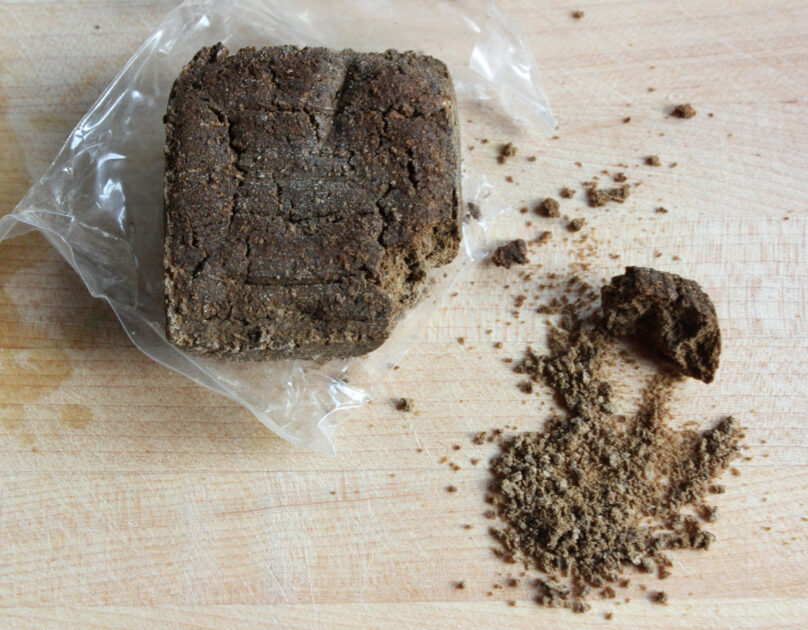
This is a photo of Malaysian balacan, which is almost identical in appearance (and very similar in taste) to Indonesian terasi. Photo: ‘dried shrimp paste belancan pre roasted’ by Andre Nguyen is licensed by CC BY 2.0
Types of sambal terasi in Indonesia
Sambal terasi recipes vary hugely within indonesia – no two restaurants seem to serve the same thing.
I think it is safe to say that the common starting point that unites all sambal terasi recipes is the following: chilli, terasi, shallot, garlic, salt and sugar that have been mashed in a cobek (the Indonesian version of a pestle and mortar which is excellent for making sambals).From this point however, things differ.
Variation is most commonly introduced in the following ways:
- 1 – Fried vs fresh – sometimes sambal terasi is served as a raw sambal, where the ingredients are simply pounded together in a cobek to make a fresh, slightly more watery sambal. Often however, the raw ingredients are fried, deep-fried or charred before being ground. Additionally, some sambal terasi recipes call for the ground sambal to be fried again after grinding. Any sort of cooking changes the flavour profile (towards sweet/stewed rather than fresh and tart) and the texture of the sambal (it becomes thicker and sometimes almost dry).
- 2 – Ratios of ingredients – sambal terasi is a simple dish with a well-established set of ingredients. Therefore it is most easy to change the nature of your sambal terasi by changing the ratio of ingredients and tastes. Warungs tend to do this either to match the food they are being served with (see below photo) or just because they have their own preferences. Some places have more chilli to make theirs spicier, some are more tomato-based (and so arguably come dangerously close to being defined as a sambal tomat), some are sweeter, others heavy on lime – it depends on the restaurant!

A photo of sambal terasi I ate at Jimbaran Fish Market (left side of the bowl). Although made from the same ingredients as other versions, this sambal terasi recipe was much heavier on the lime, which paired very well with the grilled seafood served at the warung.
- 3 – additional ingredients – this is a less common source of variation, but I have seen some sambal terasi recipes online calling for aromatics (e.g. kaffir lime leaf) to be added. Personally I have never been served anything like this in Indonesia. Once however, I was served a version that used semi-dried chilli in an ayam goreng restaurant in Solo, Java. Although still recognisably sambal terasi, it was dry in texture. It was also mind-blowingly spicy – possibly one of the hottest things I have ever eaten!
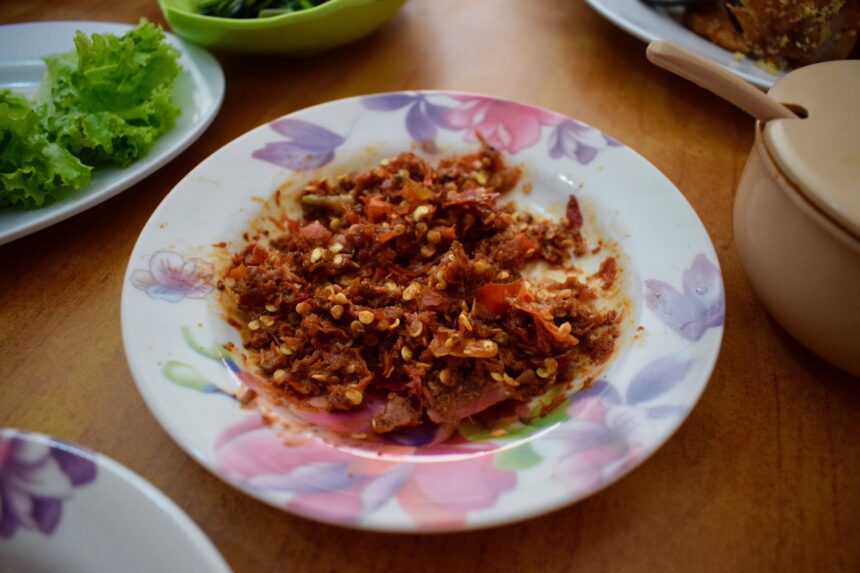
A sambal terasi I ate in Solo, Java – this unusual dry version was perhaps the hottest thing I have ever eaten.
Where is my sambal terasi recipe from?
This sambal terasi recipe is my preferred combination of all the possible variations described above. It is based all the variations I have eaten across Indonesia (including those photographed above).
I would say that this sambal terasi recipe can be considered the starting point for your own experimentation.
I have chosen:
- Fried (not fresh) – I have opted for the version where raw ingredients (and sometimes the final sambal) are fried. I have chosen this version both because it is the most common and because it is my favourite!
- Balance of tastes – I have aimed for a pleasant balance here, without going too far in any specific direction. This sambal is sweet, salty and sour, but not in a way that either of the three outcompetes the other.
- Terasi levels – I have used enough to give the sambal terasi that umami richness, but not enough that the final dish can be described as ‘fishy’ (although it will smell fishy when you’re frying the terasi!).
- Spice levels – I have been true to the versions I ate in Indonesia. This sambal terasi recipe is spicy by Indonesian standards – if you eat it on its own, it will be hot. You can always reduce the heat by reducing the number of birds-eye chillies used.
- Rustic texture – I don’t like a completely smooth sambal, I like to see chunks of tomato, chilli etc.
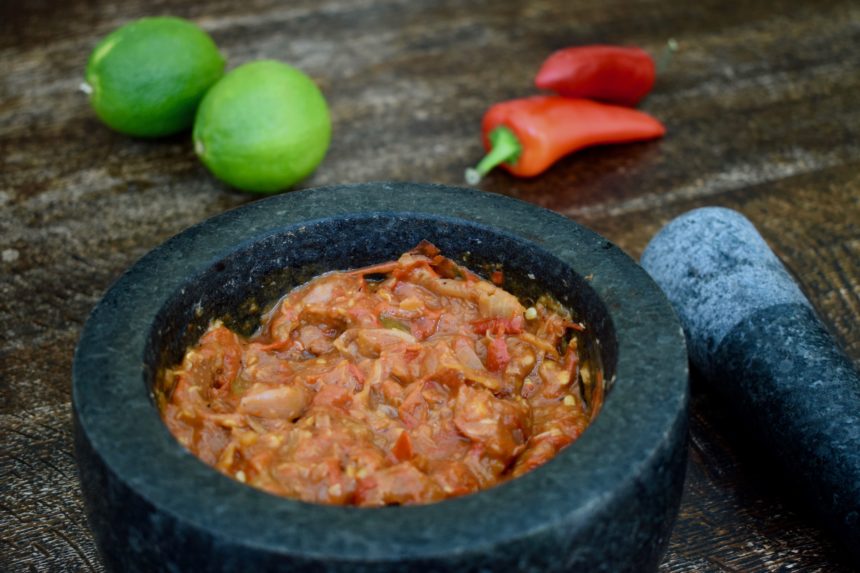
I would consider this sambal terasi recipe to be the basic starting point.
By all means I encourage you to tweak this sambal terasi recipe in various ways. If serving with seafood for example I would add a lot more lime. If you are cooking for people who aren’t great with heat, by all means reduce the chillies or deseed some. Experiment with not frying the ingredients for a fresher taste, or fry more to make it dry – there are lots of possibilities!
Cooking notes
Charring the veg
As explained earlier, I have opted for the fried version of this sambal (or ‘sambal terasi goreng’) as opposed to the fresh.
The frying helps to bring out the flavours of the vegetables, thickens the sambal, and rounds out the flavour profile to make it taste sweet and stewed (as opposed to fresh and tart).
To do this, you fry the vegetables in a very hot wok (or pan) until they have softened and developed a char (as in the photo below).

In truth, the traditional method (which I have watched first hand) is to deep-fry the vegetables in a wok filled with oil, rather than saute as I do in my recipe.
I have avoided this for a couple of reasons. Not only does it saves on oil use (the frying oil isn’t used in the final sambal anyway), but I don’t think deep-frying adds anything to the final sambal. With my method you can get extra colour onto the vegetables, which only improves the final flavour.
Grinding the sambal
In Indonesia, a cobek is used to grind the sambal into a rough paste. The cobek is a fantastic piece of equipment which is essentially a widened version of a pestle and mortar, with a curved handle on the pestle.
Don’t worry about trying to get your hands on one of these – a pestle and mortar is the next best thing. Not only is it close to the traditional method, but it gives you the most control over the final texture, which you want to be fairly rustic (as in the photo below).
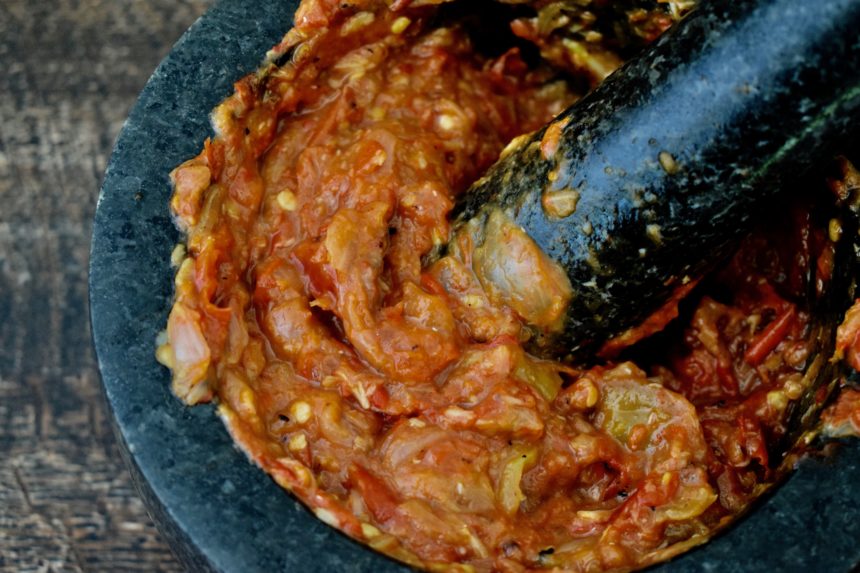
You can easily get a beautiful rustic texture using a pestle and mortar, although a food processor will also work if you are careful not to over-blend
If you do not have a pestle and mortar, then by all means use a food processor. You will still get a delicious sambal, but just make sure you are sparing on the button so that you can keep the rustic texture of the sambal terasi.
One final tip for grinding the sambal – add the sugar when you start grinding. It will act as an abrasive, which will help you break the vegetables down.
Do I need to cook after grinding?
Some sambal terasi recipes call for the paste to be fried again after grinding. This thickens the sambal further. If you take it far enough it can even become dry.
I have opted not to do this as I do not think it is necessary as an extra step. Also, if you’re not careful the final sambal can become cloying.
If you do opt to have a go, then make sure you add the lime juice right at the end. You don’t want to cook lime juice as it will not retain it’s zingy ‘freshness’.
Ingredient notes
What is terasi? What if I can’t find it?
Terasi is an Indonesian shrimp paste made from small sun-dried shrimp that have been ground into a paste. Unlike shrimp pastes from other countries, terasi comes in a hard block, which can be crumbled.
If you can find terasi where you are, then this should be your first choice as the method of production (and therefore flavour) are not quite identical to other shrimp pastes.
However, if you can’t find it (like me during the current lockdown period) then you might find Thai kapi or Malaysian belecan to be more available. Both are decent substitutes for this sambal terasi recipe because they give the umami hit and fermented fish flavour.
I find Thai kapi to be the most readily available in the UK (they sell it in supermarkets).
If you do use Thai kapi, then do be aware that it is a bit wetter than terasi. For this reason, I wouldn’t toast in a dry pan before you cook the veg as it could make a bit of a mess of your pan. Instead, fry your paste in the empty pan after cooking your veg, until it becomes slightly drier in appearance (will take 1-2 minutes).

Thai Kapi after frying – notice the dry appearance
What chillies should I use?
In Indonesia they would use small, spicy peppers that come in shades of red, orange and green.
You can’t find them in the UK. However, bird’s eye chillies are an excellent substitute.
‘Red spur chillies’ (long red chillies with little heat) are also used to add additional colour and fruitiness without making the sambal terasi too hot.
Any large, less spicy red chilli, such as the classic red serrano, will do.
As mentioned earlier, this sambal terasi recipe is spicy. If you don’t enjoy your food hot, then reduce the number of birds-eye chillies.
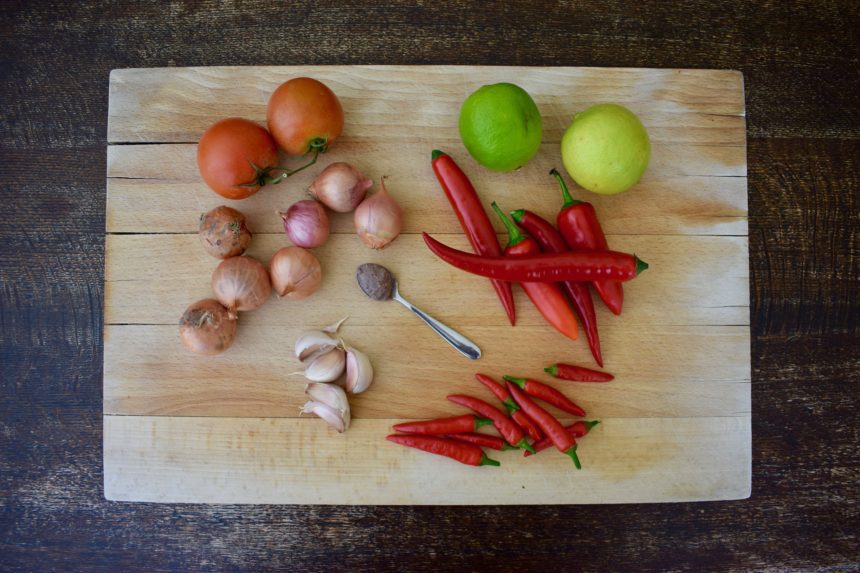
Sambal terasi ingredients – birds-eye chillies at the bottom, red serrano chillies above them.
Substituting palm sugar
Palm sugar is used in Indonesia simply because it is traditionally the most available sugar. However, it does also give a slight molasses flavour. If you want to replicate this and don’t have palm sugar, then a dark brown sugar will work well.
However, you can buy palm sugar in good Asian grocery stores (don’t worry, there aren’t the same environmental concerns as with palm oil).
Sambal terasi uses and storage
Sambal terasi is arguably the most common sambal in Indonesia.
You will find it served with everything from ikan bakar (grilled fish) and ayam goreng (fried chicken) to raw vegetables for dipping .
It is also present at most nasi campur warungs – traditional Indonesian restaurants that serve a variety of dishes (curries, stir fries, meats, eggs) alongside plain rice.

A typical plate of nasi campur in Indonesia, served with a particularly dry sambal terasi goreng (the red blob on the far right).
I recommend following the Indonesian’s lead and serving this sambal terasi with anything and everything that could benefit from a bit of heat! Serve alongside a curry, in tacos, with barbecues etc.
I recommend making a big batch when following this sambal terasi recipe and freezing the extra. To do this, wrap into a sausage shape in cling film (a bit like you would a flavoured butter) and store in a container in the freezer. You can then cut sections off to use when needed.
Sambal Terasi Recipe – authentic Indonesian shrimp paste chilli sauce
Ingredients
- 1 Tbsp oil e.g. vegetable oil
- 4 g terasi or another shrimp paste such as Malaysian belacan or Thai kapi, see 'ingredient notes' in main article for more information
- 7 shallots (around 130g) skin removed and halved
- 10 birds-eye chillies*
- 5 large red chillies (red-spur or serrano) halved lengthways
- 5 cloves of garlic peeled
- 2 large tomatoes roughly sliced into wedges
- 2 tsp lime juice around half a lime
- Palm or dark brown sugar to taste I added 1.5 tsp
- Salt to taste I added around ½ tsp of fine salt
Instructions
Toasting and Charring
- Toast your terasi for a couple of minutes in a dry non-stick pan until fragrant, then set aside. If using Thai kapi as a substitute, then I suggest frying at the end because it is wetter (see ‘Ingredient notes’ in main article for more details).
- Char your vegetables. To do this, heat the oil in a non-stick over a high heat and first add your shallots. Fry, tossing occasionally, for 2 minutes or until beginning to colour.
- Add the chillies and garlic. Continue frying and tossing occasionally until all the veg are softened and charred (around 4 minutes depending on the heat of your stove).
- Add your tomatoes to the pan and continue to fry until everything has softened and taken on some colour (again, around 4 minutes). Once your pan looks like the photo below, remove from the heat.

Grinding
- Tip the garlic, chillies, shallot, salt and sugar into the pestle and mortar. Bash until there are no large chunks and a rustic consistency is achieved (this will take around 5 minutes).

- Add the tomatoes and terasi. Bash for a further minute to incorporate.
- Squeeze in the lime juice and mix well.
- Taste and adjust the seasoning levels to your own liking (see ‘Where is my sambal terasi recipe from?’ for ideas).
